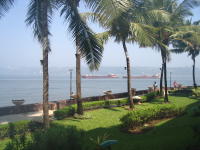G
 oing to Goa: Part II
oing to Goa: Part IIWalking the streets of Goa has been a long-held dream for Jay. He is a history buff and has read extensively of the exploits of Vasco Da Gama and the gang of Portuguese viceroys that ruled Goa for nearly 400 hundred years. Most people, however, come to Goa for the beaches.
The city of Goa is now called Old Goa. The area used to be an island. Centuries ago the River Mandovi filled up with silt and made the region a peninsula. The river supported trade as well as bringing the many epidemics that plagued the city and forced the Portuguese to move down river to a town called Panjim (or Panaji, in the local Konkani language).

We stayed in Panjim at a beautiful Marriott hotel in a ground level room overlooking the junction point of the Mandovi River and the Arabian Sea. In the evenings we sat on our little patio sipping gin & tonic, watching fishing vessels and large iron ore barges pass by. We also watched and heard the party boats with booming music motor down the river and make sharp u-turns before reaching the “official” line of the Arabian Sea and head back up river.
On our first full day in Panjim we drove around without much success looking for one museum and came upon the Historical Archives. Closed. Hmmmm.
It was then off to the Goa State Museum. Finding this nine-year-old building proved to be another challenge. When we got there we discovered it contained a number of galleries covering pre and post Portuguese history as well as a large number of displays of Christian art. Two things struck us about the museum; it was nearly deserted (more staff than visitors) and the building was in terrible condition. It was a shame to see such an endeavor to preserve history crumbling within a decade of its building. It doesn’t look like there’s much hope for the preservation of these artifacts for future generations.
 Later that evening we took a guided tour along with 7 – 8 other people from the hotel. Anthony, our tour guide, was a descendant of the Portuguese colonists. His sense of history was deeply rooted. First we visited an active Hindu temple. There were many women outside the walls selling flowers that are used in their worship. Next we toured the 500 year old blackened Catholic Church of Bom Jesus in Old Goa where the highly preserved body of St. Francis Xavier can be seen in his silver, bejeweled, windowed casket. Finally we stopped at a small market where we purchased a ½ kilo of cashews nuts. Cashew nuts are grown in abundance in Goa. One can also buy a liquor called fenni. Fenni is a super charged, clear, jet fuel alternative that is the cashew nut response to Tennessee white lightning. After sampling our small trial size bottle of fenni, we returned to the safety of our gin & tonic.
Later that evening we took a guided tour along with 7 – 8 other people from the hotel. Anthony, our tour guide, was a descendant of the Portuguese colonists. His sense of history was deeply rooted. First we visited an active Hindu temple. There were many women outside the walls selling flowers that are used in their worship. Next we toured the 500 year old blackened Catholic Church of Bom Jesus in Old Goa where the highly preserved body of St. Francis Xavier can be seen in his silver, bejeweled, windowed casket. Finally we stopped at a small market where we purchased a ½ kilo of cashews nuts. Cashew nuts are grown in abundance in Goa. One can also buy a liquor called fenni. Fenni is a super charged, clear, jet fuel alternative that is the cashew nut response to Tennessee white lightning. After sampling our small trial size bottle of fenni, we returned to the safety of our gin & tonic.

0 Comments:
Post a Comment
<< Home